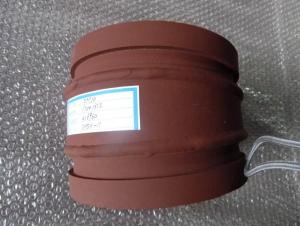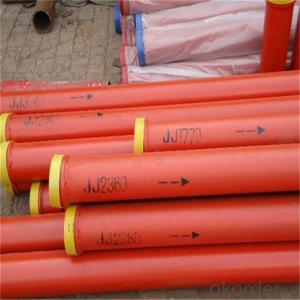Twin Wall Elbow for Concrete Pump R150 90DGR
- Loading Port:
- Tianjin
- Payment Terms:
- TT OR LC
- Min Order Qty:
- 10 pc
- Supply Capability:
- 3000 pc/month
OKorder Service Pledge
OKorder Financial Service
You Might Also Like
Twin Wall Elbow (Twin Wall Flange)
(1) Material: Q235 (outside) + GCr15(inside)
(2) Thickness: 3mm (outside) + 9mm (inside)
(3) Technology: Quenching under high temperature
(4) Characteristics: the inner rigidity to 63 HRC; the outside has so high toughness to keep the inner.
(5) Matched with: Twin wall flange, Alloy (GCr15) + 20#
(6) Working Pressure:170bar
(7) Service life: above 60,000 cubic meters.
(8) Package: PP woven bag and plastic cap
Twin wall elbow is created with research of us and need of the market. Its service life and working pressure are better than the casting. Besides, We can supply 90D, 45D, 30D, 25D, 20D, 15D, 10D. And it can be used for PM, JUNJIN, Schwing, Cifa, Sany, ect.




- Q: How often should concrete pump hydraulic filters be inspected and replaced?
- Regular inspection of the hydraulic filters for the concrete pump is recommended, preferably every three months. However, the inspection and replacement frequency may differ based on the concrete pump's specific conditions and usage. In cases where the pump is operated in harsh environments or extensively used, it may be necessary to conduct inspections and replacements more frequently. Close monitoring of the hydraulic filters' condition is crucial, and any signs of clogging, damage, or wear should prompt immediate replacement. Failure to adequately inspect and replace the filters as required can lead to reduced performance and efficiency of the concrete pump, as well as potential harm to the hydraulic system.
- Q: What are the indications of a faulty control lever?
- Some indications of a faulty control lever may include difficulty in shifting gears, a loose or wobbly lever, or the lever not returning to its original position after being released. Other signs could be grinding or crunching noises when engaging the lever, or if the lever feels sticky or unresponsive.
- Q: How can one identify the correct part number for a specific concrete pump spare part?
- To find the appropriate part number for a specific spare part for your concrete pump, there are several steps you can take: 1. Refer to the equipment manual: Start by checking the manual that accompanies your concrete pump. It should contain a comprehensive list of parts, complete with their corresponding part numbers. This is the most reliable and accurate source of information. 2. Get in touch with the manufacturer: If you don't have access to the equipment manual or it doesn't provide the necessary details, reach out to the manufacturer directly. They should be able to help you identify the correct part number for the specific spare part you require. Provide them with as much information as possible, such as the concrete pump's make, model, and serial number. 3. Utilize online resources: There are various online platforms and parts catalogs available that offer detailed information about spare parts for different concrete pump brands and models. These resources often allow you to search for the part based on your concrete pump's make and model. However, make sure to cross-reference the information with the manufacturer's specifications to ensure accuracy. 4. Seek advice from a local dealer or distributor: If you're unable to find the correct part number through the aforementioned methods, consider contacting a local dealer or distributor specializing in concrete pump spare parts. They typically possess extensive knowledge and experience in identifying and sourcing the right parts for various equipment. Provide them with all the necessary details about your concrete pump, and they should be able to assist you in finding the correct part number. Remember, accuracy is crucial when determining the correct part number for a specific concrete pump spare part. Relying on trustworthy sources and consulting professionals will help guarantee that you obtain the appropriate part to meet your equipment's requirements.
- Q: What are the preventive measures for concrete pump?
- In order to ensure the continuity of pumping concrete operation, and ensure the quality of concrete pouring, the interval between the operations should not be too long, so as to prevent clogging.
- Q: What are the functions of concrete pump truck?
- According to the structure and use of divided into drag type concrete pump, truck pump and pump car, according to the power type is divided into electric concrete pump and diesel power concrete pump
- Q: How can a faulty accumulator affect the pumping efficiency?
- A faulty accumulator can negatively impact pumping efficiency by causing inconsistent pressure and flow rates in the system. This can lead to excessive energy consumption, reduced overall performance, and potential damage to the pump and other components.
- Q: Can I get spare parts for both concrete pumps with and without lubrication systems?
- Yes, spare parts are available for both concrete pumps with and without lubrication systems.
- Q: What is the role of a concrete pump hopper grate spring?
- The role of a concrete pump hopper grate spring is to provide tension and support to the hopper grate, ensuring that it remains securely in place while allowing for smooth and consistent flow of concrete through the pump.
- Q: What do these types of concrete pumps mean?
- After the 16 is the motor power kW (landlord 16 seems to have a mistake, usually 110) or the manufacturer's serial number.
- Q: How can a faulty battery affect the operation of the pump?
- A faulty battery can significantly affect the operation of a pump. Firstly, a faulty battery may not provide enough power to the pump, resulting in slow or weak pumping action. This can impact the pump's ability to generate the necessary pressure or flow rate, leading to inefficient or ineffective operation. Additionally, a faulty battery may cause intermittent power supply to the pump. This can result in inconsistent pumping action, with the pump starting and stopping sporadically. Such interruptions can create inefficiencies, reduce the pump's performance, and potentially cause damage to the equipment or system being operated. Furthermore, a faulty battery may not hold a charge for an extended period. This can limit the pump's runtime, requiring frequent recharging or replacement of the battery. In scenarios where a pump is needed for continuous or prolonged usage, a faulty battery can disrupt operations, leading to downtime and reduced productivity. Moreover, a faulty battery can also impact the overall lifespan of the pump. If the battery does not provide the necessary power consistently, the pump may experience strain or excessive wear, potentially shortening its operational life. Overall, a faulty battery can have various adverse effects on the operation of a pump, including reduced performance, inconsistent pumping action, limited runtime, potential damage, and decreased equipment lifespan. Regular maintenance and timely replacement of faulty batteries are crucial to ensure optimal pump performance and longevity.
Send your message to us
Twin Wall Elbow for Concrete Pump R150 90DGR
- Loading Port:
- Tianjin
- Payment Terms:
- TT OR LC
- Min Order Qty:
- 10 pc
- Supply Capability:
- 3000 pc/month
OKorder Service Pledge
OKorder Financial Service
Similar products
Hot products
Hot Searches
Related keywords





























